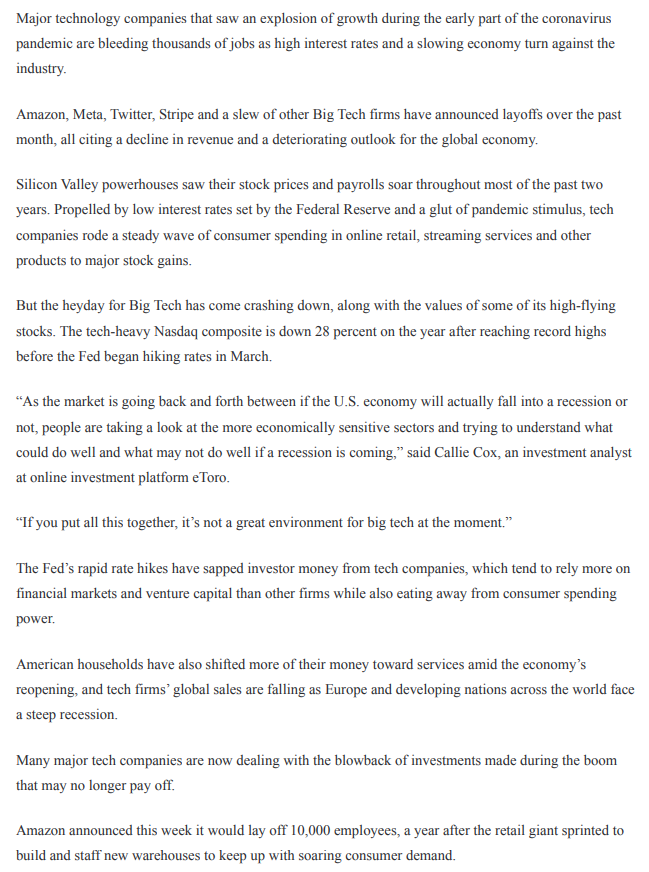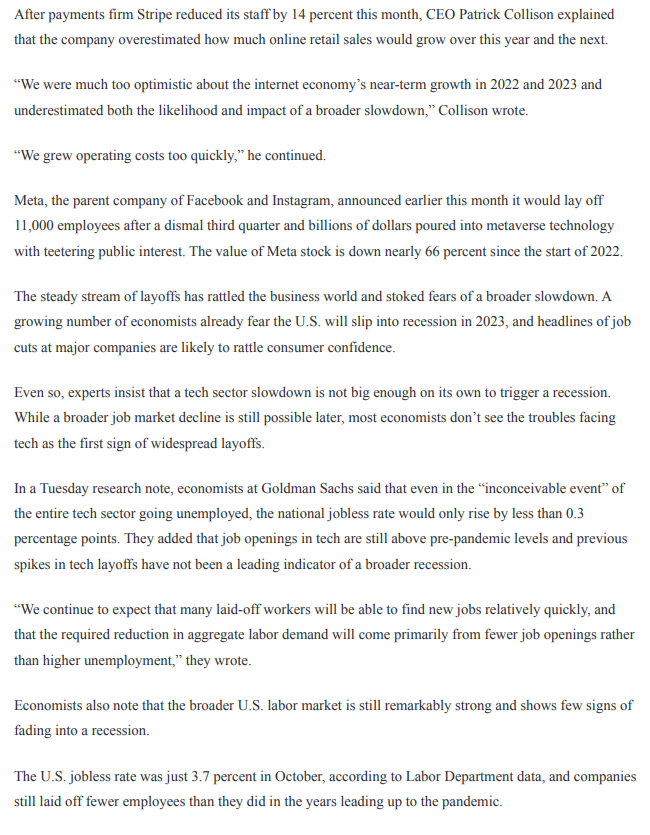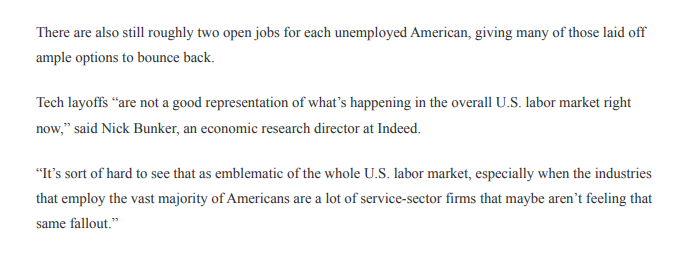Answered step by step
Verified Expert Solution
Question
1 Approved Answer
Major technology companies that saw an explosion of growth during the early part of the coronavirus pandemic are bleeding thousands of jobs as high







Major technology companies that saw an explosion of growth during the early part of the coronavirus pandemic are bleeding thousands of jobs as high interest rates and a slowing economy turn against the industry. Amazon, Meta, Twitter, Stripe and a slew of other Big Tech firms have announced layoffs over the past month, all citing a decline in revenue and a deteriorating outlook for the global economy. Silicon Valley powerhouses saw their stock prices and payrolls soar throughout most of the past two years. Propelled by low interest rates set by the Federal Reserve and a glut of pandemic stimulus, tech companies rode a steady wave of consumer spending in online retail, streaming services and other products to major stock gains. But the heyday for Big Tech has come crashing down, along with the values of some of its high-flying stocks. The tech-heavy Nasdaq composite is down 28 percent on the year after reaching record highs before the Fed began hiking rates in March. "As the market is going back and forth between if the U.S. economy will actually fall into a recession or not, people are taking a look at the more economically sensitive sectors and trying to understand what could do well and what may not do well if a recession is coming," said Callie Cox, an investment analyst at online investment platform eToro. "If you put all this together, it's not a great environment for big tech at the moment." The Fed's rapid rate hikes have sapped investor money from tech companies, which tend to rely more on financial markets and venture capital than other firms while also eating away from consumer spending power. American households have also shifted more of their money toward services amid the economy's reopening, and tech firms' global sales are falling as Europe and developing nations across the world face a steep recession. Many major tech companies are now dealing with the blowback of investments made during the boom that may no longer pay off. Amazon announced this week it would lay off 10,000 employees, a year after the retail giant sprinted to build and staff new warehouses to keep up with soaring consumer demand. After payments firm Stripe reduced its staff by 14 percent this month, CEO Patrick Collison explained that the company overestimated how much online retail sales would grow over this year and the next. "We were much too optimistic about the internet economy's near-term growth in 2022 and 2023 and underestimated both the likelihood and impact of a broader slowdown," Collison wrote. "We grew operating costs too quickly," he continued. Meta, the parent company of Facebook and Instagram, announced earlier this month it would lay off 11,000 employees after a dismal third quarter and billions of dollars poured into metaverse technology with teetering public interest. The value of Meta stock is down nearly 66 percent since the start of 2022. The steady stream of layoffs has rattled the business world and stoked fears of a broader slowdown. A growing number of economists already fear the U.S. will slip into recession in 2023, and headlines of job cuts at major companies are likely to rattle consumer confidence. Even so, experts insist that a tech sector slowdown is not big enough on its own to trigger a recession. While a broader job market decline is still possible later, most economists don't see the troubles facing tech as the first sign of widespread layoffs. In a Tuesday research note, economists at Goldman Sachs said that even in the "inconceivable event" of the entire tech sector going unemployed, the national jobless rate would only rise by less than 0.3 percentage points. They added that job openings in tech are still above pre-pandemic levels and previous spikes in tech layoffs have not been a leading indicator of a broader recession. "We continue to expect that many laid-off workers will be able to find new jobs relatively quickly, and that the required reduction in aggregate labor demand will come primarily from fewer job openings rather than higher unemployment," they wrote. Economists also note that the broader U.S. labor market is still remarkably strong and shows few signs of fading into a recession. The U.S. jobless rate was just 3.7 percent in October, according to Labor Department data, and companies still laid off fewer employees than they did in the years leading up to the pandemic. There are also still roughly two open jobs for each unemployed American, giving many of those laid off ample options to bounce back. Tech layoffs "are not a good representation of what's happening in the overall U.S. labor market right now," said Nick Bunker, an economic research director at Indeed. "It's sort of hard to see that as emblematic of the whole U.S. labor market, especially when the industries that employ the vast majority of Americans are a lot of service-sector firms that maybe aren't feeling that same fallout." (Analysis) Article 3 states that the Unemployment Rate was 3.7% in October. If the Natural Rate of Unemployment is 5%, how will the economy adjust back to Long Run Equilibrium in the AD-AS model if there is no change to Monetary or Fiscal policy (i.e., the economy adjusts back on its own)? The SRAS curve will gradually shift left as wages and input prices become flexible. The SRAS curve will gradually shift right as wages and input prices become flexible in the long run. The AD curve will gradually shift left as wages and input prices become flexible in the long run. The AD curve will gradually shift right as wages and input prices become flexible in the long run. (Analysis) Article 3 states that the Unemployment Rate was 3.7% in October. If the Natural Rate of Unemployment is 5%, what type of policy should the Federal Reserve use in order to bring the economy back to Long Run Equilibrium in the AD-AS model? Open market purchases which will decrease the interest rate. Open market purchases which will increase the interest rate. Open market sales which will decrease the interest rate. Open market sales which will increase the interest rate. (Reading) According to Article 3, tech companies have been more affected by the Federal Reserve's interest rate hikes because The Federal Reserve's interest rate hikes apply to tech companies only, all other firms are still paying the previous, lower interest rate. Most of the workers of tech companies have a lot of money invested in the stock market. Tech companies tend to be located in high cost-of-living areas which are more affected by interest rates. Tech companies rely on financial markets for funding more than other types of firms. (Reading) According to Article 3, layoffs by tech companies are not representative of the overall labor market because Many tech companies overestimated sales growth in 2022 and 2023. The tech sector is a tiny fraction (less than 1%) of overall employment. Other industries, where the vast majority of jobs are, are not experiencing the same rate of job losses. All of the above.
Step by Step Solution
★★★★★
3.37 Rating (169 Votes )
There are 3 Steps involved in it
Step: 1
The detailed answer for the above question is provided below It is not uncommon for companies to go through cycles of growth and contraction During the early part of the COVID19 pandemic many tech com...
Get Instant Access to Expert-Tailored Solutions
See step-by-step solutions with expert insights and AI powered tools for academic success
Step: 2

Step: 3

Ace Your Homework with AI
Get the answers you need in no time with our AI-driven, step-by-step assistance
Get Started


